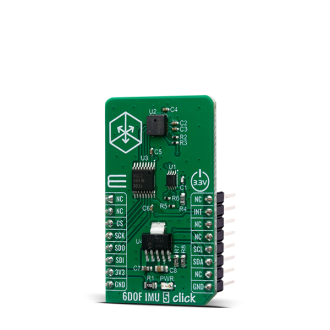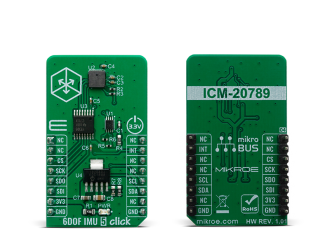
We strongly encourage users to use Package manager for sharing their code on Libstock website, because it boosts your efficiency and leaves the end user with no room for error. [more info]

Rating:
Author: MIKROE
Last Updated: 2020-05-05
Package Version: 1.0.0.0
mikroSDK Library: 1.0.0.0
Category: Motion
Downloaded: 3198 times
Not followed.
License: MIT license
6DOF IMU 5 Click features 7-Axis ICM-20789 chip, an integrated 6-axis inertial device that combines a 3-axis gyroscope, 3-axis accelerometer, and an ultra-low noise MEMS capacitive pressure sensor.
Do you want to subscribe in order to receive notifications regarding "6DOF IMU 5 Click" changes.
Do you want to unsubscribe in order to stop receiving notifications regarding "6DOF IMU 5 Click" changes.
Do you want to report abuse regarding "6DOF IMU 5 Click".


Library Description
The library covers all the necessary functions that enables the usage of the 6DOF IMU 5 Click board. It initializes and defines the SPI and I2C bus drivers and drivers that offer a plethora of settings. The library also offers functions that allow reading of accelerometer,gyroscope pressure and temperature, as well as generic read and write function that offer reading( and writing ) of different lenghts of data.
Key functions:
float *z_ang_rte ); - Function is used to calculate angular rate.float *z_accel_rte ); - Function is used to calculate acceleration rate.float *temperature ); - Function processes raw data in order to get presure (in Pascals) and temperature(in degree Centigrade).Examples description
The application is composed of three sections :
void application_task ( )
{
c6dofimu5_angular_rate( &x_gyro, &y_gyro, &z_gyro );
mikrobus_logWrite( "Angular rate: ", _LOG_LINE );
FloatToStr( x_gyro, log_txt );
mikrobus_logWrite( "X-axis: ", _LOG_TEXT );
Ltrim( log_txt );
mikrobus_logWrite( log_txt, _LOG_LINE );
FloatToStr( y_gyro, log_txt );
mikrobus_logWrite( "Y-axis: ", _LOG_TEXT );
Ltrim( log_txt );
mikrobus_logWrite( log_txt, _LOG_LINE );
FloatToStr( z_gyro, log_txt );
mikrobus_logWrite( "Z-axis: ", _LOG_TEXT );
Ltrim( log_txt );
mikrobus_logWrite( log_txt, _LOG_LINE );
mikrobus_logWrite( "---------------------", _LOG_LINE );
c6dofimu5_acceleration_rate( &x_accel, &y_accel, &z_accel );
mikrobus_logWrite( "Acceleration rate: ", _LOG_LINE );
FloatToStr( x_accel, log_txt );
mikrobus_logWrite( "X-axis: ", _LOG_TEXT );
Ltrim( log_txt );
mikrobus_logWrite( log_txt, _LOG_LINE );
FloatToStr( y_accel, log_txt );
mikrobus_logWrite( "Y-axis: ", _LOG_TEXT );
Ltrim( log_txt );
mikrobus_logWrite( log_txt, _LOG_LINE );
FloatToStr( z_accel, log_txt );
mikrobus_logWrite( "Z-axis: ", _LOG_TEXT );
Ltrim( log_txt );
mikrobus_logWrite( log_txt, _LOG_LINE );
mikrobus_logWrite( "---------------------", _LOG_LINE );
c6dofimu5_read_raw_data( &raw_pres, &raw_temp );
c6dofimu5_process_data ( raw_pres, raw_temp, &pressure, &temperature );
FloatToStr( pressure, log_txt );
mikrobus_logWrite( "Pressure: ", _LOG_TEXT );
Ltrim( log_txt );
mikrobus_logWrite( log_txt, _LOG_LINE );
FloatToStr( temperature, log_txt );
mikrobus_logWrite( "Temperature: ", _LOG_TEXT );
Ltrim( log_txt );
mikrobus_logWrite( log_txt, _LOG_LINE );
mikrobus_logWrite( "---------------------", _LOG_LINE );
mikrobus_logWrite( "", _LOG_LINE );
mikrobus_logWrite( "---------------------", _LOG_LINE );
Delay_ms( 1000 );
}
Other mikroE Libraries used in the example:
Additional notes and informations
Depending on the development board you are using, you may need USB UART click, USB UART 2 click or RS232 click to connect to your PC, for development systems with no UART to USB interface available on the board. The terminal available in all MikroElektronika compilers, or any other terminal application of your choice, can be used to read the message.